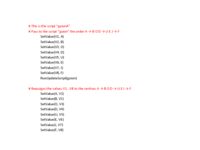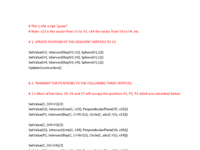Free articulated cube
This activity belongs to the GeoGebra book Linkages.
In this construction you can manipulate the articulated cube with no more restriction than that imposed by the relative distances of its 8 vertices, that is, by the 1 unit length of its 12 bars. The colors of the vertices and the triangles simply serve to favor the visualization of the state of the cube at each moment, since all the vertices behave in the same way.
At any time you can change the position of any vertex (for example, B) by its isomer (B'), using the corresponding box in the left panel.
The construction uses two levels of scripts. The first script is executed when moving a vertex. Suppose, for example, that we move point A. When we do so, the script guionA will be executed, which assigns the positions of the vertices to the points V1, ..., V8, following an order:
- Point V1 takes the position of A.
- Points V2, V3 and V4 take the position of the vertices next to A: O, B and D.
- Points V5, V6 and V7 take the position of the vertices contiguous to the previous ones: U, E, J.
- Finally, point V8 takes the position of F.
guionA
guion
Author of the construction of GeoGebra: Rafael Losada

